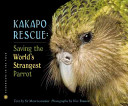
On remote Codfish Island off the southern coast of New Zealand live the last ninety-one kakapo parrots on earth. These trusting, flightless, and beautiful birds—the largest and most unusual parrots on earth—have suffered devastating population loss. Now, on an island refuge with the last of the species, New Zealand’s National Kakapo Recovery Team is working to restore the kakapo population. With the help of fourteen humans who share a single hut and a passion for saving these odd ground-dwelling birds, the kakapo are making a comeback in New Zealand. Follow intrepid animal lovers Sy Montgomery and Nic Bishop on a ten-day excursion to witness the exciting events in the life of the kakapo.
- ISBN: 9780618494170
- Author: Montgomery, Sy
- Published: 2010 , Houghton Mifflin Harcourt
- Themes: extinction, Parrots, protection, Scientists
- Descriptors: Intermediate (ages 9-14), New Zealand, Nonfiction, Oceania
- No. of pages: 80

Once a large, green, flightless parrot that “smells like vanilla” roamed New Zealand by the millions. Now, the remaining 90 Kakapo can only be found on secluded Codfish Island, where they are safe from feral cats, dogs, and other introduced species that have brought this strange and magnificent bird to the brink of extinction. What strikes me about this book in addition to the striking photography and wonderfully written text, is the story of the scientists and volunteers who take extraordinary measures to save the kakapo. The book’s portrayal of the conservation efforts includes and historical overview of a familiar story (similar to the now extinct dodo bird, Stellar’s sea cow, and great auk) of what happens as a result of immigration and the unintended introduction of unnatural predators and habitat destruction. It also documents for the reader the exhaustive dedication of people who work to protect those without voice, often with heart breaking set backs and limited successes, and provides insight into how future generations can work to protect and save the planet’s delicate and diverse wildlife. The opportunities for inquiry into the multiple and complex ways we are interconnected both as people and to our environment are rich with possibility.